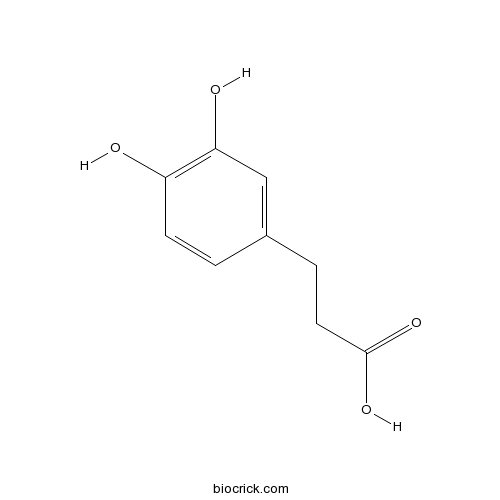3,4-Dihydroxybenzenepropanoic acidCAS# 1078-61-1 |

Quality Control & MSDS
3D structure
Package In Stock
Number of papers citing our products

| Cas No. | 1078-61-1 | SDF | Download SDF |
| PubChem ID | 348154 | Appearance | Powder |
| Formula | C9H10O4 | M.Wt | 182.17 |
| Type of Compound | N/A | Storage | Desiccate at -20°C |
| Solubility | Soluble in Chloroform,Dichloromethane,Ethyl Acetate,DMSO,Acetone,etc. | ||
| Chemical Name | 3-(3,4-dihydroxyphenyl)propanoic acid | ||
| SMILES | C1=CC(=C(C=C1CCC(=O)O)O)O | ||
| Standard InChIKey | DZAUWHJDUNRCTF-UHFFFAOYSA-N | ||
| Standard InChI | InChI=1S/C9H10O4/c10-7-3-1-6(5-8(7)11)2-4-9(12)13/h1,3,5,10-11H,2,4H2,(H,12,13) | ||
| General tips | For obtaining a higher solubility , please warm the tube at 37 ℃ and shake it in the ultrasonic bath for a while.Stock solution can be stored below -20℃ for several months. We recommend that you prepare and use the solution on the same day. However, if the test schedule requires, the stock solutions can be prepared in advance, and the stock solution must be sealed and stored below -20℃. In general, the stock solution can be kept for several months. Before use, we recommend that you leave the vial at room temperature for at least an hour before opening it. |
||
| About Packaging | 1. The packaging of the product may be reversed during transportation, cause the high purity compounds to adhere to the neck or cap of the vial.Take the vail out of its packaging and shake gently until the compounds fall to the bottom of the vial. 2. For liquid products, please centrifuge at 500xg to gather the liquid to the bottom of the vial. 3. Try to avoid loss or contamination during the experiment. |
||
| Shipping Condition | Packaging according to customer requirements(5mg, 10mg, 20mg and more). Ship via FedEx, DHL, UPS, EMS or other couriers with RT, or blue ice upon request. | ||

3,4-Dihydroxybenzenepropanoic acid Dilution Calculator

3,4-Dihydroxybenzenepropanoic acid Molarity Calculator
| 1 mg | 5 mg | 10 mg | 20 mg | 25 mg | |
| 1 mM | 5.4894 mL | 27.4469 mL | 54.8938 mL | 109.7876 mL | 137.2345 mL |
| 5 mM | 1.0979 mL | 5.4894 mL | 10.9788 mL | 21.9575 mL | 27.4469 mL |
| 10 mM | 0.5489 mL | 2.7447 mL | 5.4894 mL | 10.9788 mL | 13.7234 mL |
| 50 mM | 0.1098 mL | 0.5489 mL | 1.0979 mL | 2.1958 mL | 2.7447 mL |
| 100 mM | 0.0549 mL | 0.2745 mL | 0.5489 mL | 1.0979 mL | 1.3723 mL |
| * Note: If you are in the process of experiment, it's necessary to make the dilution ratios of the samples. The dilution data above is only for reference. Normally, it's can get a better solubility within lower of Concentrations. | |||||

Calcutta University

University of Minnesota

University of Maryland School of Medicine

University of Illinois at Chicago

The Ohio State University

University of Zurich

Harvard University

Colorado State University

Auburn University

Yale University

Worcester Polytechnic Institute

Washington State University

Stanford University

University of Leipzig

Universidade da Beira Interior

The Institute of Cancer Research

Heidelberg University

University of Amsterdam

University of Auckland

TsingHua University

The University of Michigan

Miami University

DRURY University

Jilin University

Fudan University

Wuhan University

Sun Yat-sen University

Universite de Paris

Deemed University

Auckland University

The University of Tokyo

Korea University
- Coccinic acid
Catalog No.:BCN5877
CAS No.:107783-45-9
- A 61603 hydrobromide
Catalog No.:BCC6912
CAS No.:107756-30-9
- Zafirlukast
Catalog No.:BCC4881
CAS No.:107753-78-6
- Methyl 7beta,15-dihydroxydehydroabietate
Catalog No.:BCN7270
CAS No.:107752-10-3
- Epleremone
Catalog No.:BCC3776
CAS No.:107724-20-9
- MDL 11,939
Catalog No.:BCC6822
CAS No.:107703-78-6
- beta-Lipoic acid
Catalog No.:BCC9198
CAS No.:6992-30-9
- Merucathine
Catalog No.:BCN1782
CAS No.:107673-74-5
- Bulleyaconitine A
Catalog No.:BCN1210
CAS No.:107668-79-1
- Merucathinone
Catalog No.:BCN1783
CAS No.:107638-80-2
- Erycibelline
Catalog No.:BCN1876
CAS No.:107633-95-4
- Dehydroformouregine
Catalog No.:BCN4054
CAS No.:107633-69-2
- PF 04418948
Catalog No.:BCC6299
CAS No.:1078166-57-0
- Exemestane
Catalog No.:BCC1061
CAS No.:107868-30-4
- Quinovin
Catalog No.:BCN5878
CAS No.:107870-05-3
- Dehydrodiconiferyl alcohol 4-O-beta-D-glucopyranoside
Catalog No.:BCN7707
CAS No.:107870-88-2
- Japonicones D
Catalog No.:BCN3614
CAS No.:1078711-42-8
- Isoeleutherin
Catalog No.:BCN8315
CAS No.:1078723-14-4
- Ganodermanondiol
Catalog No.:BCN5879
CAS No.:107900-76-5
- Sibiricose A5
Catalog No.:BCN2785
CAS No.:107912-97-0
- 9,9-Bis(4-amino-3-methylphenyl)fluorene
Catalog No.:BCC8794
CAS No.:107934-60-1
- Myricananin A
Catalog No.:BCN5880
CAS No.:1079941-35-7
- 2-(Dimethylamino)ethanol
Catalog No.:BCN1798
CAS No.:108-01-0
- Resorcinol
Catalog No.:BCN5881
CAS No.:108-46-3
Preparation and application of a poly (ionic liquid)-based molecularly imprinted polymer for multiple monolithic fiber solid-phase microextraction of phenolic acids in fruit juice and beer samples.[Pubmed:28960220]
Analyst. 2017 Oct 23;142(21):4039-4047.
In this work, a new molecularly imprinted polymer (MIP) using a poly (ionic liquid) (PIL) as a functional monomer was prepared and utilized as the extraction medium of multiple monolithic fiber solid-phase microextraction (MMF-SPME). A PIL, 1-ally-3-vinylimidazolium chloride, was used as a functional monomer, and 3,4-Dihydroxybenzenepropanoic acid (DBA) and ethylene dimethacrylate were chosen as the template molecule and cross-linker, respectively, to synthesize the PIL/MIP. Under the optimized preparation conditions, the recognition coefficient of PIL-MIP for DBA was as high as 11.6. The combination of PIL/MIP-MMF-SPME and high-performance liquid chromatography with diode array detection (HPLC/DAD) was developed for the sensitive determination of phenolic acids (PAs) in fruit juice and beer samples. Under the optimal conditions which were investigated in detail, the limits of detection (LODs, S/N = 3) for PAs in fruit juice were 0.024-0.24 mug L(-1), and the related values were 0.011-0.052 mug L(-1) for the beer sample. The intra-day and inter-day precision (relative standard deviations, n = 4, %) at 1.0 and 100.0 mug L(-1) spiking concentration were both less than 10%. In the analysis of PAs in fruit juice and beer samples, satisfactory recoveries and repeatability were achieved. In comparison with reported approaches, the proposed method exhibited some advantages including high selectivity, convenience, satisfactory sensitivity and environmental friendliness.


